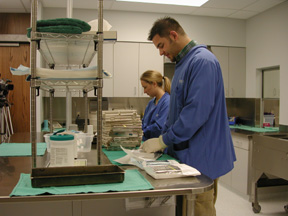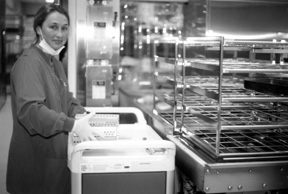 |
Dental aides Brandi Nutzman and Drew Hoffman prepare cassettes of dental instruments for use in College of Dentistry clinics. Nutzman and Hoffman work in the college’s new Central Sterilization and Dispensing Area. Photo by Peggy Cain. |
Splashes of blue add a finishing touch to the UNMC College of Dentistry’s new Central Sterilization and Dispensing Area.
Joan Sivers, D.D.S., assistant dean of clinics, said the blue trim on the walls, the blue lockers where students collect their instruments and supplies and the blue clinic coats worn by staff liven up the 1,500 square-foot room where instruments are cleaned, sterilized, packaged and distributed using state-of-the art procedures and equipment.
In addition to offering efficiency and the latest high-tech equipment, she said, the room was designed to be a pleasant and safe place to work.
The equipment is stainless steel, countertops are stainless steel or Corian and the floor is specially sealed to withstand chemical spills and make cleanup easy. Lighting was planned to make the room light and airy. An intricate air-handling system eliminates dangerous vapors and prevents air in the contaminated area from flowing into the clean area. And temperature controls keep the heat-generating equipment from overheating the room.
“It is a cleaner atmosphere,” said Rhonda Simpson, supervisor of the sterilization area.
“It’s a much safer environment for all of us. I am happy and excited about the new equipment. It makes the task of decontamination more efficient.”
$1.8 million project
The $1.8 million project combined the college’s sterilization services, previously located in four separate areas, in one central location in the lower level of the college. The department of oral biology, which was relocated, formerly occupied much of the area. In addition to the new central dispensing area, the dispensing area on first floor is being renovated and a new drop-off area is being created to serve North and South clinics. A new elevator also is being installed for easy access between the clinics and the sterilization area.
 |
Dental aide Brandi Nutzman pauses as she prepares cassettes for the washer-disinfector in the new Central Sterilization and Dispensing Area at the UNMC College of Dentistry. Photo by Jana Miller. |
Michael Molvar, D.D.S., assistant dean for patient services and quality officer, said the new area became necessary as sterilization protocols became more refined and personnel and equipment more specialized. The new area allows for greater efficiency and a safe work environment for students and staff, he said. At the same time, the area makes it possible for the college to maintain the same attention to high-quality infection control for patients that it always has.
In addition to bettering the workplace for employees and offering state-of-the-art infection control procedures for patients, Dr. Sivers said the new Central Sterilization and Dispensing Area “will enhance the education of every student. It’s what they can strive for in their offices.”
The project, which was five or more years in the making, was financed largely by private donations through the college’s Centennial Campaign and through gifts from UNMC, Drs. Sivers and Molvar said. No state money was used.
Hospital-quality
The new area consists of a hospital-quality washer-disinfector that is unique in dental settings, Dr. Molvar said. Cassettes of instruments pass through the washer-disinfector in the first stage of the sterilization process, which takes 35 minutes. The entire cleaning and sterilization process takes about one and one-half hours from start to finish. The washer-disinfector destroys about 98 percent of all pathogens, including bacteria and viruses, but not spores. The system results in “a tremendous decrease in the risk of transmission of infection from patients to staff who handle the instruments,” he said.
After being cleaned in the washer-disinfector, the cassettes pass into the sterilization area where they are opened and the instruments inspected. The cassettes are then packaged in bags. The bags, paper on one side and clear on the other, allow for quick identification and keep the instruments sterile.
 |
Dental Aide Brandi Nutzman loads one of the autoclaves in the new Central Sterilization and Dispensing Area at the UNMC College of Dentistry. Photo by Peggy Cain. |
The bags are loaded into one of three autoclaves where steam from the NU generating plant kills any remaining pathogens. The stainless steel autoclaves are set at 272 degrees F. From the autoclaves, the bags are sent to a storage area where they are readied for distribution to students. The bar-coded bags are checked out to students by computer and dispensed through lockers in a mailbox-like system.
Simpson said certain instruments that cannot be put through the washer-disinfector, such as handpieces, ultrasonic scalers and plastic products, require specialized hand cleaning and packaging. Burs and surgical instruments are cleaned in an ultrasonic washer using an enzyme solution and vibration prior to wrapping and sterilization in the autoclave. Equipment, instruments and reusable containers of materials that cannot withstand the sterilization process are disinfected with a chemical spray in an area that is hooded to remove dangerous vapors. Heavy-duty gloves, safety glasses and masks are routine safety measures for staff, Simpson said.